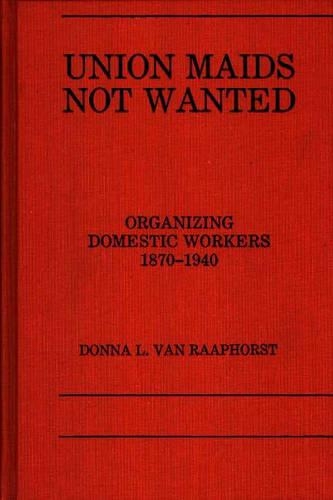
Union Maids Not Wanted: Organizing Domestic Workers 1870-1940
(Hardback)
Publishing Details
Union Maids Not Wanted: Organizing Domestic Workers 1870-1940
By (Author) D L Van Raaphorst
Bloomsbury Publishing PLC
Praeger Publishers Inc
12th May 1988
United States
Classifications
Tertiary Education
Non Fiction
331.481640460973
Physical Properties
Hardback
317
Description
Housework and domestic service have become popular topics within the scholarly community. . . Van Raaphorst . . . adds to this growing literature by illuminating the efforts to organize domestics in the years from the Civil War to WWII. The book does much more than this however. It surveys the period from early colonization to the 1930s and divides the history of domestic service into four distinct chronological eras. . . . The author examines the psychology of housework and assesses the occupation from the perspectives of the employer and employee. Finally, she sketches the seemingly innumerable but inevitably fleeting attempts to better the lot of the domestic either through organization or unionization. Choice Union Maids Not Wanted offers a comprehensive investigation of why the most populous group of the female workforce, domestic workers, was unable to establish long-lasting, powerful unions as have other groups of laborers. The author chronicles the number of colorful yet failed attempts at organization throughout the period of 1870-1940, analyzing the factors which worked together to prevent successful unionization. She systematically examines the psychology and nature of domestic work, union rejection of domestic laborers, employers' opposition to organization, and the frequent disagreements among the domestics themselves. Finally, she demonstrates how these factors affected the orientation of domestic workers to the organized labor movement as a whole and as a force within their own ranks.
Reviews
Housework and domestic service have become popular topics within the scholarly community. Not only did domestic service rank as the largest employer of women until well into the 20th century, it embodied a number of characteristics that we associate with women's work. Van Raaphorst, in this revision of her doctoral dissertation, adds to this growing literature by illuminating the efforts to organize domestics in the years from the Civil War to WW II. The book does much more than this, however. It surveys the period from early colonijzation to the 1930s and divides the history of domestic service into four distinct chronological eras. Using the methodology set forward by David Brody in his Steelworkers in America: The Nonunion Era (1960), the author examines the psychology of housework and assesses the occupation from the perspectives of the employer and employee. Finally, she sketches the seemingly innumerable but inevitably fleeting attemtps to better the lot of the domestic either through organization or unionization. . . for institutions with strong women's studies programs, this book merits purchase.-Choice
Researchers in social and economic history will welcome Van Raaphorst's study of the plight of domestic labor between 1870 and 1940. It is a treasure of sources; indeed, it is often a bibliographical essay and there is also a 45 page bibliography.-Academic Library Book Review
"Researchers in social and economic history will welcome Van Raaphorst's study of the plight of domestic labor between 1870 and 1940. It is a treasure of sources; indeed, it is often a bibliographical essay and there is also a 45 page bibliography."-Academic Library Book Review
"Housework and domestic service have become popular topics within the scholarly community. Not only did domestic service rank as the largest employer of women until well into the 20th century, it embodied a number of characteristics that we associate with women's work. Van Raaphorst, in this revision of her doctoral dissertation, adds to this growing literature by illuminating the efforts to organize domestics in the years from the Civil War to WW II. The book does much more than this, however. It surveys the period from early colonijzation to the 1930s and divides the history of domestic service into four distinct chronological eras. Using the methodology set forward by David Brody in his Steelworkers in America: The Nonunion Era (1960), the author examines the psychology of housework and assesses the occupation from the perspectives of the employer and employee. Finally, she sketches the seemingly innumerable but inevitably fleeting attemtps to better the lot of the domestic either through organization or unionization. . . for institutions with strong women's studies programs, this book merits purchase."-Choice
Author Bio
DONNA L.VAN RAAPHORST is Associate Professor of History and Social Science at Cyahoga Community College in Ohio.
